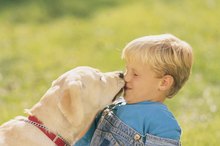Signs an Infant Has a Dog Allergy
Kids love pets, so parents may not realize that their infants have dog allergies until they have already adopted and bonded with a puppy. When suspicions allergy symptoms appear, it may be too late to break up the budding relationship. Parents can look for signs of infant and child allergy problems before deciding on pet ownership. The American Kennel Club suggests exposing family members to various dog breeds ahead of time and KidsHealth recommends allergy skin testing 1.
Runny Nose
Allergic reactions to dog dander send histamines into babies’ bloodstreams. This allows fluid to accumulate in the nasal passages, to be shed as mucus. The University of Maryland Medical Center reports that animal allergies represent one form of perennial allergic rhinitis, whose classic symptom is a runny nose 3. Nasal drainage with no fever present may indicate dog allergies in infants.
- Allergic reactions to dog dander send histamines into babies’ bloodstreams.
- This allows fluid to accumulate in the nasal passages, to be shed as mucus.
Stuffy Nose
Why Does My Dog's Saliva Make My Skin Itch?
Learn More
Histamine inflammatory action and the accumulation of too much mucus will cause nasal congestion. Allergy symptoms of stuffy noses in babies, absent of other cold or flu symptoms, may mean problems with dog dander. Infants do not even need to touch dogs to develop nasal symptoms.
Sneezing
Histamines in the blood also trigger the sneezing reflex in humans. Congestion and sneezing in babies may obstruct breathing to form one of the more obvious signs of infant allergy. According to the Asthma and Allergy Foundation of America, sneezing that takes place only after contact with dogs may indicate pet allergy problems 5. Sneezing that continues after removing a dog from the home doesn’t necessarily indicate an absence of sensitivity, because dog dander can remain in indoor environments for months.
- Histamines in the blood also trigger the sneezing reflex in humans.
- Sneezing that continues after removing a dog from the home doesn’t necessarily indicate an absence of sensitivity, because dog dander can remain in indoor environments for months.
Nose Wiping
A Bird Allergy With a Skin Rash
Learn More
Additional dog allergy symptoms include itching of the mucous membranes, which may begin before other respiratory symptoms. Parents who notice their babies repeatedly rubbing their noses with an upward movement might be right to suspect dog allergies.
Eye Rubbing
Eye rubbing may be a sign of dog allergies in babies. UMMC relates that histamine-induced eye itching indicates allergic rhinitis as well. Infants who have had physical contact through petting dogs or from dogs licking their hands, and who then rub their eyes, may be spreading allergens in that manner, too.
Skin Rash
Babies’ skin is soft and sensitive. Infants may experience allergic reactions to direct contact with dog dander. Skin allergy symptoms include red, itchy rashes, which may have raised bumps, or hives.
Related Articles
References
- American Kennel Club: AKC Breeds and Varieties
- University of Maryland Medical Center: Allergic Rhinitis
- HealthyChildren.org: When Pets Are the Problem
- Asthma and Allergy Foundation of America: Pet Allergies
- American Academy of Allergy Asthma & Immunology. Allergic Reactions.
- Kołodziejczyk K, Bozek A. Clinical Distinctness of Allergic Rhinitis in Patients with Allergy to Molds. Biomed Res Int. 2016;2016:3171594. doi:10.1155/2016/3171594
- American Academy of Allergy Asthma & Immunology. All About Allergy Testing.
- Bernstein IL, Li JT, Bernstein DI, et al. Allergy Diagnostic Testing: An Updated Practice Parameter. Ann Allergy Asthma Immunol. 2008;100(3 Suppl 3):S1-148. (Current as of Sept. 2019). doi:10.1016/S1081-1206(10)60305-5
- Carr S, Chan E, Lavine E, Moote W. CSACI Position Statement on the Testing of Food-Specific IgG. Allergy Asthma Clin Immunol. 2012;8(1):12. Published 2012 Jul 26. doi:10.1186/1710-1492-8-12
- Fonacier L, Bernstein DI, Pacheco K, et al. Contact Dermatitis: A Practice Parameter-Update 2015. J Allergy Clin Immunol Pract. 2015;3(3 Suppl):S1-39. doi:10.1016/j.jaip.2015.02.009
Writer Bio
Nancy Clarke began writing in 1988 after achieving her Bachelor of Arts in English and has edited books on medicine, diet, senior care and other health topics. Her related affiliations include work for the American Medical Association and Oregon Health Plan.









